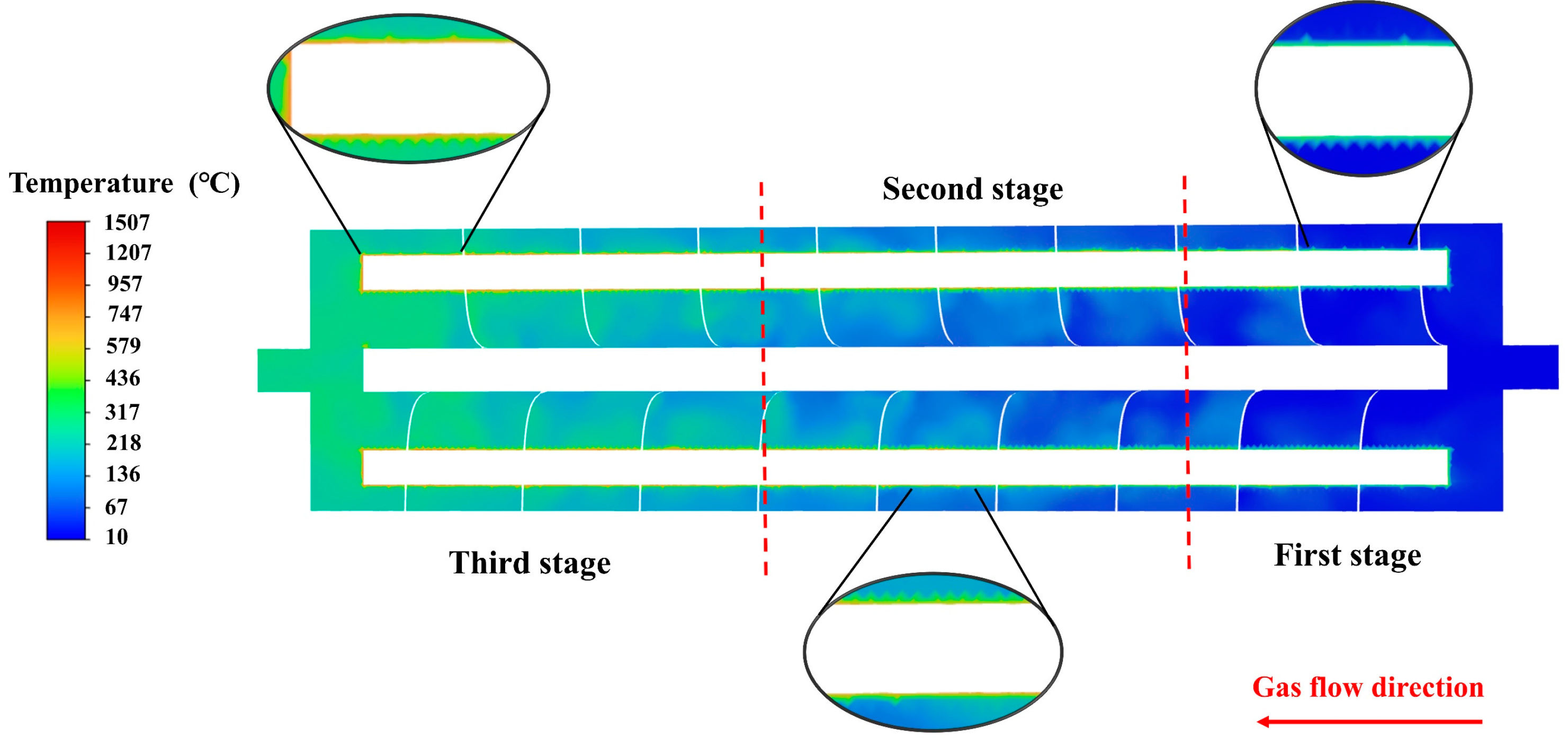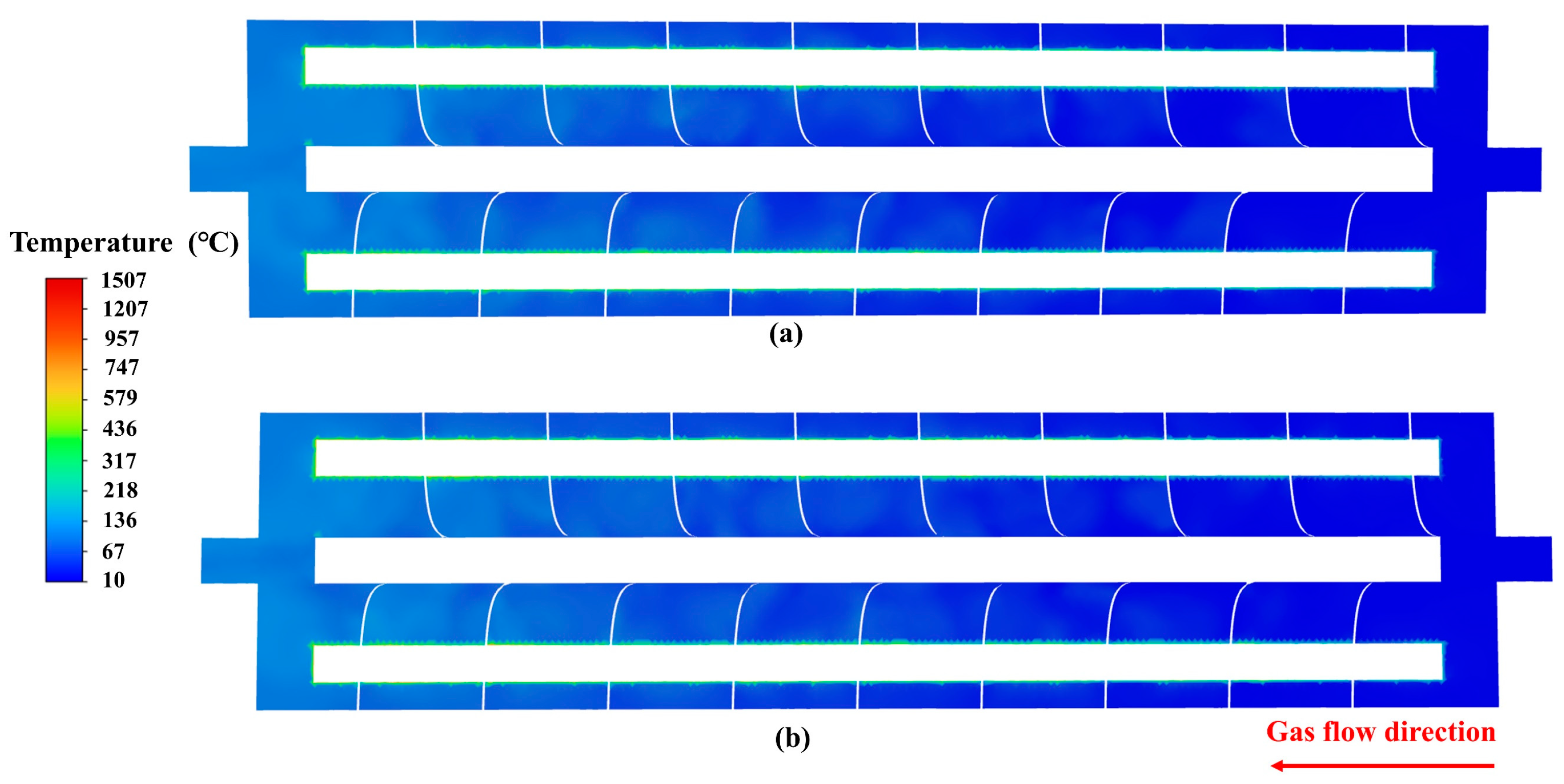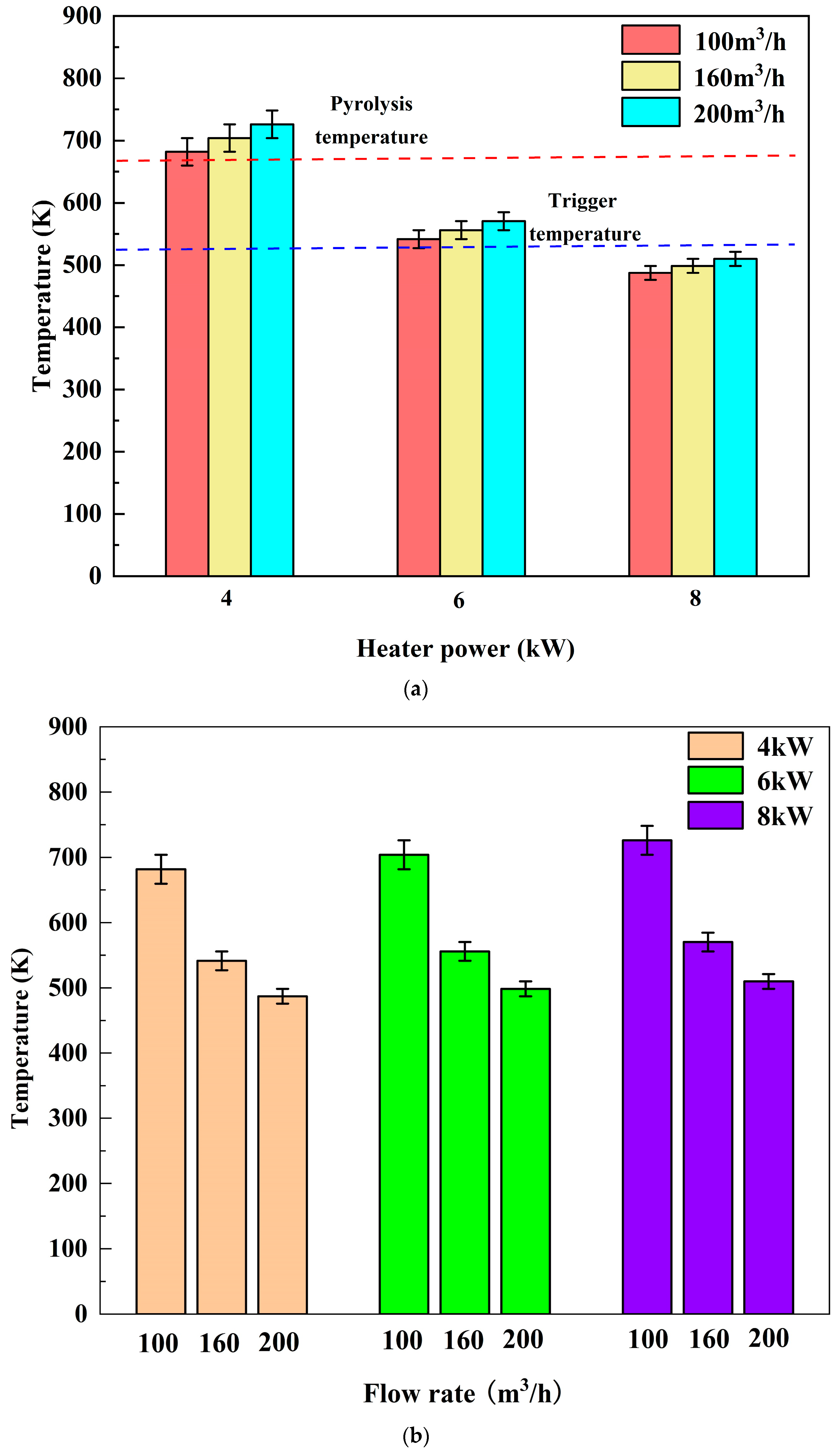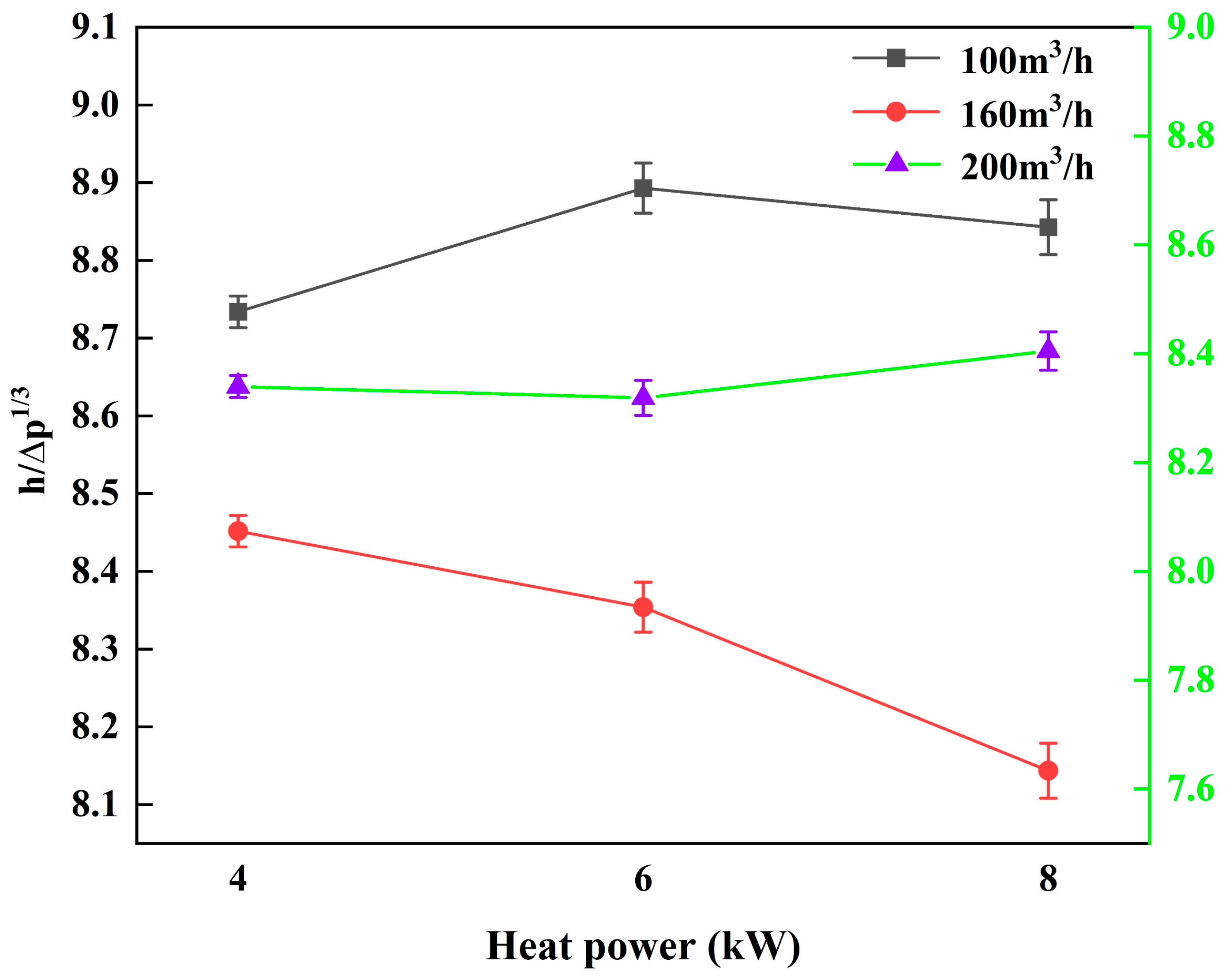Numerical Heat Transfer Simulation of Oil Shale Large-Size Downhole Heater
Abstract
:1. Introduction
2. Materials and Methods
- The shell-side fluid was a fully developed turbulent flow in a steady state;
- The fluid in the helical channel was incompressible;
- The heat dissipation on the external wall of the shell cylinder was ignored;
- The heating rods were regarded as walls with a constant heat flux density;
- The specific heat capacity of air, thermal conductivity, and dynamic viscosity with temperature were fitted by segmented polynomials, and density was considered a constant.
3. Results
3.1. Heating Rod Surface Temperature
3.2. Outlet Temperature Response Characterization
3.3. Comprehensive Performance
4. Discussion
4.1. Heater Temperature Characterization
4.2. Field Application Measures
5. Conclusions
- Upon injecting gas into the heater, the gas temperature rapidly increases due to the absence of helical baffle constraints at the gas input, leading to enhanced heat transmission. As the gas temperature rises, it essentially reaches the temperature required for oil shale maturation at the output. Heat accumulates on the surface of the heating rod as the temperature gradient with the gas decreases. Lowering the heating power while increasing the injected gas flow rate can reduce the distribution area and density of high-temperature hot spots on the heating rod’s surface. In practical working conditions, the authors believe that reducing the heating power of the heating rod is more feasible.
- The gas heating rate at the outlet exhibits two stages, with a diminished temperature rise as the shell length increases and a theoretical maximum value for the heater’s outlet temperature. An energy exchange balance between heating power and injected gas flow rate ensures more efficient energy utilization and extends the heater’s service life. As a result, the outlet temperature, also referred to as the actual temperature, cannot surpass the theoretical temperature in this operational situation.
- The pressure distribution in the shell decreases linearly. Gas viscosity gradually increases as the gas flow channel lengthens. Simultaneously, the local differential pressure resistance and frictional resistance of the heater in the well increase, causing a further decline in the flow rate of the injected gas. Adopting as the heat transfer performance evaluation index, it was found that the optimal heat transfer performance was attained at 100 m3/h. However, heat transfer performance was notably impacted by heating power at 200 m3/h, with the former surpassing the latter by approximately 6%. Moreover, heat transfer performance was most stable at 160 m3/h.
- The gas heating stage of the heater was characterized by a rapid warming stage, a steady warming stage, and an over-heating stage, determined by the temperature distribution and temperature change on the surface of the heating rods. Due to the larger size of the heater, a greater volume and area can be utilized for the heating rods, enhancing the heater’s heating performance. Controlling the flow rate of the injected gas and the heating power enables efficient in situ heating of the oil shale.
Author Contributions
Funding
Institutional Review Board Statement
Informed Consent Statement
Data Availability Statement
Conflicts of Interest
References
- He, W.T.; Sun, Y.H.; Shan, X.L. Organic matter evolution in pyrolysis experiments of oil shale under high pressure: Guidance for in situ conversion of oil shale in the Songliao Basin. J. Anal. Appl. Pyrolysis 2021, 155, 105091. [Google Scholar] [CrossRef]
- Liu, Z.J.; Meng, Q.T.; Dong, Q.S.; Zhu, J.W.; Guo, W.; Ye, S.Q.; Liu, R.; Jia, J.L. Characteristics and resource potential of oil shale in china. Oil Shale 2017, 34, 15–41. [Google Scholar] [CrossRef]
- Guo, K.; Li, H.L.; Yu, Z.X. In-situ heavy and extra-heavy oil recovery: A review. Fuel 2016, 185, 886–902. [Google Scholar] [CrossRef]
- Slorach, P.C.; Stamford, L. Net zero in the heating sector: Technological options and environmental sustainability from now to 2050. Energy Convers. Manag. 2021, 230, 113838. [Google Scholar] [CrossRef]
- Mu, M.; Han, X.; Jiang, X. Combined fluidized bed retorting and circulating fluidized bed combustion system of oil shale: 3. Exergy analysis. Energy 2018, 151, 930–939. [Google Scholar] [CrossRef]
- Guo, W.; Li, Q.; Deng, S.H.; Wang, Y.; Zhu, C.F. Mechanism and reservoir simulation study of the autothermic pyrolysis in-situ conversion process for oil shale recovery. Pet. Sci. 2023, 20, 1053–1067. [Google Scholar] [CrossRef]
- Pang, X.Q.; Li, M.; Li, B.Y.; Wang, T.; Hui, S.S.; Liu, Y.; Liu, G.Y.; Hu, T.; Xu, T.W.; Jiang, F.J.; et al. Main controlling factors and movability evaluation of continental shale oil. Earth-Sci. Rev. 2023, 243, 104472. [Google Scholar] [CrossRef]
- Liu, H.; Sun, T.F.; Zhang, Y.; Wu, B.K.; Wang, Z.L.; Fan, Y.C. Design of oil shale in-situ extraction heater structure and numerical simulation of the fracturing process. Chem. Technol. Fuels Oils 2023, 58, 990–1004. [Google Scholar] [CrossRef]
- Sun, T.F.; Liu, H.; Yan, T.J.; Zhang, Y.; Wu, B.K.; Liu, Z.Y.; Wang, Z.L.; Fan, Y.C.; Li, Y.A.; Han, Y.L. Innovative design and numerical simulation research of downhole electrical heaters for in-situ oil shale exploitation. SPE Prod. Oper. 2023, 38, 627–639. [Google Scholar] [CrossRef]
- Hassanzadeh, H.; Harding, T. Analysis of conductive heat transfer during in-situ electrical heating of oil sands. Fuel 2016, 178, 290–299. [Google Scholar] [CrossRef]
- Babazadeh Shareh, F. Development of a Subsurface Heater Technology for In-Situ Heating; The University of Utah: Salt Lake City, UT, USA, 2018. [Google Scholar]
- Wang, Y.W.; Wang, Y.; Deng, S.H.; Li, Q.; Gu, J.J.; Shui, H.C.; Guo, W. Numerical simulation analysis of heating effect of downhole methane catalytic combustion heater under high pressure. Energies 2022, 15, 1186. [Google Scholar] [CrossRef]
- Chen, Y.; Zeng, H.; Wang, J.L.; Chen, H.R.; Zhu, J.J. Heat transfer performance of a downhole electric tubular resistive heater. Appl. Sci. 2022, 12, 9508. [Google Scholar] [CrossRef]
- Shui, H.C.; Wang, Y.; Liu, Z.; Guo, W. Optimal parameter adjustment of catalytic combustion heaters for oil shale in-situ conversion of low calorific value gases. J. Cleaner Prod. 2023, 426, 139020. [Google Scholar] [CrossRef]
- Dong, X.L.; Duan, Z.Y.; Nie, T.G.; Gao, D.L. An analytical model for reservoir temperature during electromagnetic heating based on power transmission. Appl. Therm. Eng. 2023, 219, 119–441. [Google Scholar] [CrossRef]
- Guo, L.; Kuang, J.; Liu, S.B.; Shen, S.J.; Liang, L. Failure mechanism of a coil type crude oil heater and optimization method. Case Stud. Therm. Eng. 2022, 39, 112–122. [Google Scholar] [CrossRef]
- Klein, K.; Kattel, E.; Goi, A.; Kivi, A.; Dulova, N.; Saluste, A.; Zekker, I.; Trapido, M.; Tenno, T. Combined treatment of pyrogenic wastewater from oil shale retorting. Oil Shale 2017, 34, 82–96. [Google Scholar] [CrossRef]
- Kang, Z.Q.; Zhao, Y.S.; Yang, D. Review of oil shale in-situ conversion technology. Appl. Energy 2020, 269, 115–121. [Google Scholar] [CrossRef]
- Wang, Z.X.; Gao, D.L.; Diao, B.B.; Tan, L.C.; Zhang, W.; Liu, K. Comparative performance of electric heater vs. RF heating for heavy oil recovery. Appl. Therm. Eng. 2019, 160, 114105. [Google Scholar] [CrossRef]
- Guo, W.; Zhang, X.; Deng, S.H.; Sun, Y.H.; Han, J.; Bai, F.T.; Kang, S.J.; He, W.T. Enhanced pyrolysis of Huadian oil shale at high temperature in the presence of water and air atmosphere. J. Pet. Sci. Eng. 2022, 215, 110–623. [Google Scholar] [CrossRef]
- Hosseini, R.K. A reliability study of API 530 for predicting creep life of long-service exposed 9Cr-1Mo steel tubes. Mater. High Temp. 2022, 39, 590–595. [Google Scholar] [CrossRef]
- Ramirez, J.; Zambrano, A.; Ratkovich, N. Prediction of temperature and viscosity profiles in heavy-oil producer wells implementing a downhole induction heater. Processes 2023, 11, 631. [Google Scholar] [CrossRef]
- Montilla, M.J.B.; Li, S.D.; Zhang, Z.B.; Li, X.; Sun, Y.M.; Ma, S.W. Theoretical Analysis of the Effect of Electrical Heat In Situ Injection on the Kerogen Decomposition for the Development of Shale Oil Deposits. Energies 2023, 16, 5007. [Google Scholar] [CrossRef]
- Zhu, X.; Pang, Y.; He, J.; Wu, Y.; Ge, J.; Shen, L.; Yang, J.; Qu, M. An intelligent superhydrophobic absorbent with electrothermal conversion performance for effective high-viscosity oil removal and oil–water separation. J. Mater. Sci. 2022, 57, 18787–18805. [Google Scholar] [CrossRef]
- Gao, B.; Bi, Q.C.; Nie, Z.S.; Wu, J.B. Experimental study of effects of baffle helix angle on shell-side performance of shell-and-tube heat exchangers with discontinuous helical baffles. Exp. Therm. Fluid Sci. 2015, 68, 48–57. [Google Scholar] [CrossRef]
- Yang, S.F.; Chen, Y.P.; Wu, J.F.; Gu, H.D. Influence of baffle configurations on flow and heat transfer characteristics of unilateral type helical baffle heat exchangers. Appl. Therm. Eng. 2018, 133, 739–748. [Google Scholar] [CrossRef]
- Wang, Y.J.; Charbal, A.; Hild, F.; Roux, S.; Vincent, L. Crack initiation and propagation under thermal fatigue of austenitic stainless steel. Int. J. Fatigue 2019, 124, 149–166. [Google Scholar] [CrossRef]
- Zhu, J.Y.; Yi, L.P.; Yang, Z.Z.; Li, X.G. Numerical simulation on the in situ upgrading of oil shale reservoir under microwave heating. Fuel 2021, 287, 119553. [Google Scholar] [CrossRef]
- Sheikholeslami, M.; Ganji, D.D. Heat transfer enhancement in an air to water heat exchanger with discontinuous helical turbulators; experimental and numerical studies. Energy 2016, 116, 341–352. [Google Scholar] [CrossRef]
- Khakimova, L.; Askarova, A.; Popov, E.; Moore, R.G.; Solovyev, A.; Simakov, Y.; Afanasiev, I.; Belgrave, J.; Cheremisin, A. High-pressure air injection laboratory-scale numerical models of oxidation experiments for Kirsanovskoye oil field. J. Pet. Sci. Eng. 2020, 188, 106796. [Google Scholar] [CrossRef]
- Wang, D.J.; Katory, M.; Li, Y.S. Analytical and experimental investigation on the hydrodynamic performance of onshore wave-power devices. Ocean Eng. 2002, 29, 871–885. [Google Scholar] [CrossRef]
- Song, X.Z.; Zhang, C.K.; Shi, Y.; Li, G.S. Production performance of oil shale in-situ conversion with multilateral wells. Energy 2019, 189, 116145. [Google Scholar] [CrossRef]
- Yang, J.F.; Lin, Y.S.; Ke, H.B.; Zeng, M.; Wang, Q.W. Investigation on combined multiple shell-pass shell-and-tube heat exchanger with continuous helical baffles. Energy 2016, 115, 1572–1579. [Google Scholar] [CrossRef]
- Wang, Z.D.; Lu, X.S.; Li, Q.; Sun, Y.H.; Wang, Y.; Deng, S.H.; Guo, W. Downhole electric heater with high heating efficiency for oil shale exploitation based on a double-shell structure. Energy 2020, 211, 118539. [Google Scholar] [CrossRef]
- Wang, Z.D.; Yang, F.; Fu, D.L.; Ma, L.; Duan, Z.H.; Wang, Q.W.; Kang, S.J.; Guo, W. Economic and heating efficiency analysis of double-shell downhole electric heater for tar-rich coal in-situ conversion. Case Stud. Therm. Eng. 2023, 41, 102596. [Google Scholar] [CrossRef]
- Gao, Y.; Wan, T.; Dong, Y.; Li, Y.Y. Numerical and experimental investigation of production performance of in-situ conversion of shale oil by air injection. Energy Rep. 2022, 8, 15740–15753. [Google Scholar] [CrossRef]
- Ambekar, A.S.; Sivakumar, R.; Anantharaman, N.; Vivekenandan, M. CFD simulation study of shell and tube heat exchangers with different baffle segment configurations. Appl. Therm. Eng. 2016, 108, 999–1007. [Google Scholar] [CrossRef]










| Item | Dimension (mm) |
|---|---|
| Shell inside diameter | 260 |
| Shell outside diameter | 270 |
| Shell length | 1100 |
| Inlet and outlet nozzle diameter | 40 |
| Battle length | 1000 |
| Battle thickness | 2 |
| Helical pitch | 110 |
| Central tube outside diameter | 40 |
| Effective length of heating rod | 1000 |
| Heating rod outside diameter | 32 |
| Number of heating rods | 8 |
| Heating rod layout pattern | 45° rotation |
Disclaimer/Publisher’s Note: The statements, opinions and data contained in all publications are solely those of the individual author(s) and contributor(s) and not of MDPI and/or the editor(s). MDPI and/or the editor(s) disclaim responsibility for any injury to people or property resulting from any ideas, methods, instructions or products referred to in the content. |
© 2024 by the authors. Licensee MDPI, Basel, Switzerland. This article is an open access article distributed under the terms and conditions of the Creative Commons Attribution (CC BY) license (https://creativecommons.org/licenses/by/4.0/).
Share and Cite
Bu, Q.; Li, Q.; Li, X. Numerical Heat Transfer Simulation of Oil Shale Large-Size Downhole Heater. Appl. Sci. 2024, 14, 2235. https://doi.org/10.3390/app14062235
Bu Q, Li Q, Li X. Numerical Heat Transfer Simulation of Oil Shale Large-Size Downhole Heater. Applied Sciences. 2024; 14(6):2235. https://doi.org/10.3390/app14062235
Chicago/Turabian StyleBu, Qingfeng, Qiang Li, and Xiaole Li. 2024. "Numerical Heat Transfer Simulation of Oil Shale Large-Size Downhole Heater" Applied Sciences 14, no. 6: 2235. https://doi.org/10.3390/app14062235






